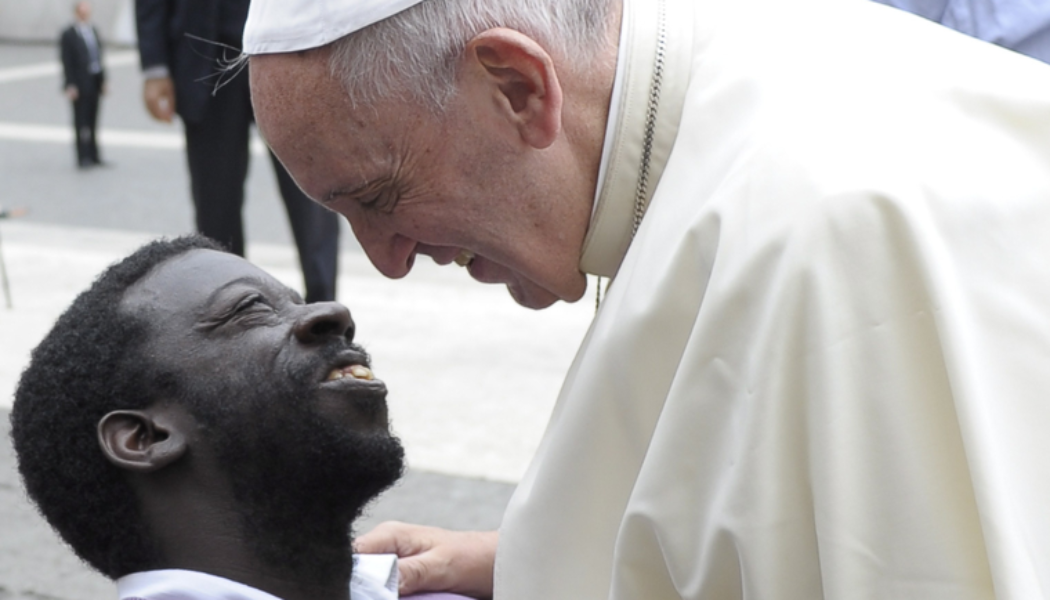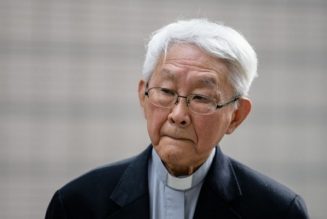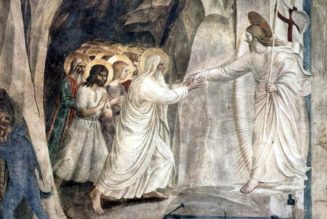
The promise of the pontificate of Pope Francis has its roots in a Christmas card of sorts. On Christmas Day 2005, Pope Benedict XVI signed Deus Caritas Est (God Is Love), his first encyclical. There, he defined the mission of the Church:
“The Church’s deepest nature is expressed in her threefold responsibility: of proclaiming the word of God (kerygma-martyria), celebrating the sacraments (leitourgia), and exercising the ministry of charity (diakonia). These duties presuppose each other and are inseparable. For the Church, charity is not a kind of welfare activity which could equally well be left to others, but is a part of her nature, an indispensable expression of her very being.”
When Pope Francis was elected 10 years ago, on March 13, 2013, he spoke of his dream of a “poor Church for the poor.” The providential promise of the pontificate became immediately evident.
After the great witness (martyria) of the heroic Polish Church in St. John Paul the Great, and the profound teacher of right worship (leitourgia) in Pope Benedict XVI, the Church now had a pope to emphasize that third essential mission, the ministry of charity (diakonia).
“After a great doctor of the Church like Benedict and a great evangelizer — John Paul II — you needed a man that is close to the people and helps people to walk the way of following Christ, to be accompanied, and to be understood with a merciful heart,” said Cardinal Marc Ouellet, prefect of bishops for all 10 years under Pope Francis. “That’s what the Church needed at the time.”
“The Church is God’s family in the world,” continued Benedict in his encyclical. “In this family no one ought to go without the necessities of life. The parable of the Good Samaritan remains as a standard which imposes universal love towards the needy whom we encounter ‘by chance’ (Luke 10:31), whoever they may be.”
In due course, Pope Francis would lift up the Parable of the Good Samaritan repeatedly, employing it magisterially to frame Fratelli Tutti (All Brothers), his encyclical on human fraternity.
The dominant images of the pontificate are those of the Holy Father embracing the suffering, the afflicted and the forgotten. In his first year, the moving embrace of the disfigured man in St. Peter’s Square was an encounter that moved the entire world.
His elevation of the office of the “papal almoner,” who carries out concrete acts of charity for the Holy Father, was another early emphasis on diakonia. Making the almoner, Archbishop Konrad Krajewski, a cardinal was another. Cardinal Krajewski, now head of the Dicastery for the Service of Charity, has become the cardinalatial face of the pontificate, whether providing showers and haircuts for Rome’s homeless or praying beside a mass grave in Ukraine on Good Friday 2022.
In 2013, after 35 years of John Paul and Benedict, there was relative doctrinal and liturgical peace in the Church. Their greatest collaboration, the 1992 Catechism of the Catholic Church, offered a definitive answer to the doctrinal chaos of the 1970s. The following year, Veritatis Splendor (The Splendor of Truth) was published, the first time an encyclical addressed the foundations of moral theology, a response to the moral relativism rampant in the world and seeping into the Church.
The liturgical silly season was over. Abuses are never absent, but the center of gravity had shifted. Cardinal Joseph Ratzinger’s 1999 book, The Spirit of the Liturgy, and his eight years as pope had reoriented the Church’s liturgy toward right worship of God, an encounter with the biblical word and sacramental communion.
All this set the stage for the man from Buenos Aires, the “bishop of the slums” who knew the poor of his city by name, who visited their homes and comforted them in adversity.
The promise of the pontificate shone brightly in the Holy Father’s first major document, Evangelii Gaudium (The Joy of the Gospel), in which Pope Francis called the entire Church to a “missionary conversion.” Every ecclesial action, every program and project, every baptized Catholic was called to proclamation and witness (kerygma-martyria). He wrote some 5,000 words on preaching the homily (leitourgia).
The relative peace did not hold. The 10 years of Pope Francis have not been serene. Doctrinal and liturgical controversies have returned. What happened in the 1970s is happening again; the Church’s energy for diakonia is being absorbed by fights over doctrine, morals and liturgy.
In the 1970s, there was fear that the Dutch Church might be headed toward de facto schism after falling into various heterodoxies. Fifteen months after his election, John Paul spent two weeks with all the bishops of Holland in Rome, the “Dutch Synod,” to heal divisions and point that local Church back toward the orthodox faith.
On the 10th anniversary of Pope Francis, the much larger German Church has concluded a three-year Synodal Way against the express wishes of the Holy Father. The majority of Germany’s bishops have endorsed both doctrinal and liturgical positions at odds with the Catholic Tradition. The crisis in Germany threatens the unity of the Church and will consume whatever remains of the Francis pontificate.
The German disruption of doctrinal and liturgical peace means a certain sidelining of the service of charity. For that, Pope Francis himself must take some of the blame.
The great project of his first years, the twin synods on the family, 2014 and 2015, called into question the doctrinal and liturgical tradition as it relates to marriage, confession and Holy Communion. He wrote Amoris Laetitia (The Joy of Love) as if Veritatis Splendor did not exist, never referring to it in more than 400 citations.
Indeed, the eighth chapter of Amoris Laetitia was a kind of pontifical palimpsest, writing over, as it were, the relevant sections of Veritatis Splendor. But like the ancient palimpsest manuscripts, the original text still shines through, calling into question the new teaching.
Thus the original promise of the pontificate has only been partially realized. The triplex mission of which Benedict spoke is “inseparable.” In 2005, Benedict reminded the Church that the service of charity was not optional, or less essential than doctrine and sacraments. After 10 years of Pope Francis, this reminder about the Church’s threefold nature remains relevant. Authentic diakonia cannot be separated from doctrine, lest the Church became just another NGO.
The Holy Father warned against that on his first full day as pope in 2013. And his warning still holds, but it is now a more present danger than it was 10 years ago.







